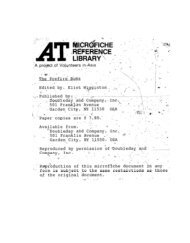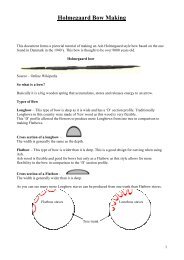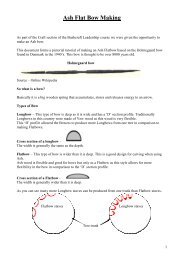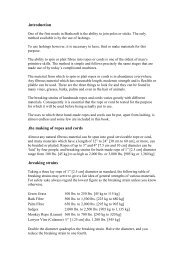Experiments on Knife Sharpening John D. Verhoeven ... - BushcraftUK
Experiments on Knife Sharpening John D. Verhoeven ... - BushcraftUK
Experiments on Knife Sharpening John D. Verhoeven ... - BushcraftUK
You also want an ePaper? Increase the reach of your titles
YUMPU automatically turns print PDFs into web optimized ePapers that Google loves.
the 600 grit wheels were largely removed by the buffing operati<strong>on</strong>.A small bur was c<strong>on</strong>sistently found <strong>on</strong> all of the blades and a measure of the edgewidth was made <strong>on</strong> each of the blades using the SEM micorgraphs. Table 4 presents asummary of the range of edge width values found for the 8 blades. There were two clearresults of this study. (1) The T edge of the blades possessed thinner burs than the Aedges. In additi<strong>on</strong>, the burs al<strong>on</strong>g the T edge were more uniform than al<strong>on</strong>g the A edge.This result can be seen by comparing Blade 2T to Blade 3Ain Fig. 40. (2) The use of the 2-step buffing operati<strong>on</strong> <strong>on</strong>blades 4, c<strong>on</strong>sistently produced thinner burs than any of thesingle step operati<strong>on</strong>s used <strong>on</strong> blades 1 to 3. The variati<strong>on</strong>sof the buffing procedures employed with blades 1 to 3, seeTable 3, did not produce any significant change in edgequality.Table 4 Measurements of edge widths.Blade Edge width Blade Edge width1T 0.8-2 µm 1A 1-5 µm2T 0.8-2 µm 2A 1-5 µm3T 0.8-2 µm 3A 1-5 µm4T 0.3 -2µm 4A 0.5 - 5 µmThe 2-step buffing operati<strong>on</strong> used the coarser compound for the first step <strong>on</strong> acloth wheel, followed by the finer compound <strong>on</strong> a felt wheel. It is comm<strong>on</strong> practice inmetallograhic polishing of metals to proceed from coarse to fine grit abrasives. It hasbeen the experience of this author that employing this progressive type of polishing ismuch more effective at producing smoother final surfaces. It seems likely that a similareffect occurs here, with the use of a 2-step progressive grit size procedure able to reducethe edge bur more effectively than the use of just the final fine grit compound.Additi<strong>on</strong>al experiments would be needed to verify this possibility. The reas<strong>on</strong> why thebur size <strong>on</strong> the A edges were significantly larger than <strong>on</strong> the T edges is unknown. Herealso, additi<strong>on</strong>al experiments are needed to determine the source of this variati<strong>on</strong>.Cross Secti<strong>on</strong>al OutlinesThe optical images of the polished cross secti<strong>on</strong>s ofthe blades were collected digitally. The digital images were then processed <strong>on</strong> a pc tosuperimpose a white line al<strong>on</strong>g the outer surfaces of the blades, as shown for two of theblades in Fig. 41. The extensi<strong>on</strong> of the outlines to the crossover point allows a reas<strong>on</strong>ableestimate of the original shape of the blade prior to buffing. The original geometry of theedge was known from secti<strong>on</strong>s of unbuffed blades. It is apparent from Fig. 41 that <strong>on</strong>e33








